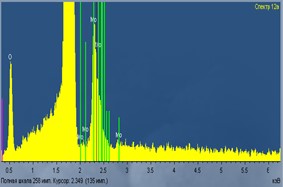Осадження тонких плівок оксиду молібдену для гнучкої біорозкладної електроніки
Основний зміст сторінки статті
Анотація
У статті розглянуто використання біополімерного матеріалу (наноцелюлози) як гнучкої підкладки для осадження функціональних шарів електронних приладів. Плівки оксиду молібдену осаджувались на поверхню наноцелюлози методом йонно-променевого розпилення в низькотемпературних режимах без наступного відпалу. Було виміряно спектри оптичної прозорості отриманих зразків у вихідному та зігнутому станах та встановлено вплив пружної деформації зразку з радіусом згину 5 мм на коефіцієнт оптичного пропускання в ультрафіолетовому, видимому та інфрачервоному діапазонах спектру. При цьому було показано, що оптична прозорість вихідних зразків під час згину може зменшуватись на 12-15% порівняно з вихідним станом. Мінімальна величина впливу згину на коефіцієнт оптичного пропускання (від 0,7 до 3,3%) спостерігається для плівок оксиду молібдену, синтезованих за температури 50°С. Одержані результати можуть бути використані при розробці гнучких електронних приладів на основі оксиду молібдену.
Блок інформації про статтю

Ця робота ліцензується відповідно до Creative Commons Attribution 4.0 International License.
Автори, які публікуються у цьому журналі, погоджуються з наступними умовами:- Автори залишають за собою право на авторство своєї роботи та передають журналу право першої публікації цієї роботи на умовах ліцензії Creative Commons Attribution License, котра дозволяє іншим особам вільно розповсюджувати опубліковану роботу з обов'язковим посиланням на авторів оригінальної роботи та першу публікацію роботи у цьому журналі.
- Автори мають право укладати самостійні додаткові угоди щодо неексклюзивного розповсюдження роботи у тому вигляді, в якому вона була опублікована цим журналом (наприклад, розміщувати роботу в електронному сховищі установи або публікувати у складі монографії), за умови збереження посилання на першу публікацію роботи у цьому журналі.
- Політика журналу дозволяє і заохочує розміщення авторами в мережі Інтернет (наприклад, у сховищах установ або на особистих веб-сайтах) рукопису роботи, як до подання цього рукопису до редакції, так і під час його редакційного опрацювання, оскільки це сприяє виникненню продуктивної наукової дискусії та позитивно позначається на оперативності та динаміці цитування опублікованої роботи (див. The Effect of Open Access).
Посилання
J. van den Brand et al., “Flexible and stretchable electronics for wearable health devices,” Solid. State. Electron., vol. 113, pp. 116–120, Nov. 2015, DOI: https://doi.org/10.1016/j.sse.2015.05.024.
Y. Zhang et al., “Flexible transparent high-voltage diodes for energy management in wearable electronics,” Nano Energy, vol. 40, pp. 289–299, Oct. 2017, DOI: https://doi.org/10.1016/j.nanoen.2017.08.025.
M.-S. Tsai, P.-G. Su, and C.-J. Lu, “Fabrication of a highly sensitive flexible humidity sensor based on Pt/polythiophene/reduced graphene oxide ternary nanocomposite films using a simple one-pot method,” Sensors Actuators B Chem., vol. 324, p. 128728, Dec. 2020, DOI: https://doi.org/10.1016/j.snb.2020.128728.
H. Jeong, Y. Noh, and D. Lee, “Highly stable and sensitive resistive flexible humidity sensors by means of roll-to-roll printed electrodes and flower-like TiO2 nanostructures,” Ceram. Int., vol. 45, no. 1, pp. 985–992, Jan. 2019, DOI: https://doi.org/10.1016/j.ceramint.2018.09.276.
Y. Zhang et al., “Ultrasensitive flexible NH3 gas sensor based on polyaniline/SrGe4O9 nanocomposite with ppt-level detection ability at room temperature,” Sensors Actuators B Chem., vol. 319, p. 128293, Sep. 2020, DOI: https://doi.org/10.1016/j.snb.2020.128293.
V. A. Barbash, O. V. Yashchenko, and O. A. Vasylieva, “Preparation and Properties of Nanocellulose from Miscanthus x giganteus,” J. Nanomater., vol. 2019, pp. 1–8, Nov. 2019, DOI: https://doi.org/10.1155/2019/3241968.
V. Koval, V. Barbash, M. Dusheyko, V. Lapshuda, O. Yashchenko, and Y. Yakimenko, “Application of Nanocellulose in Humidity Sensors for Biodegradable Electronics,” in 2020 IEEE 10th International Conference Nanomaterials: Applications & Properties (NAP), 2020, pp. 02NS01-1-02NS01-5, DOI: https://doi.org/10.1109/NAP51477.2020.9309598.
N. P. Klochko et al., “Use of biomass for a development of nanocellulose-based biodegradable flexible thin film thermoelectric material,” Sol. Energy, vol. 201, pp. 21–27, May 2020, DOI: https://doi.org/10.1016/j.solener.2020.02.091.
N. Saba and M. Jawaid, “Recent advances in nanocellulose-based polymer nanocomposites,” in Cellulose-Reinforced Nanofibre Composites, Elsevier, 2017, pp. 89–112, DOI: https://doi.org/10.1016/B978-0-08-100957-4.00004-8.
C. Battaglia et al., “Hole Selective MoO x Contact for Silicon Solar Cells,” Nano Lett., vol. 14, no. 2, pp. 967–971, Feb. 2014, DOI: https://doi.org/10.1021/nl404389u.
Y. Zhou et al., “High moisture-resistive MoOx/metal/graphite barrier films with excellent thermal dissipation for the encapsulation of organic electronics,” Org. Electron., vol. 86, p. 105817, Nov. 2020, DOI: https://doi.org/10.1016/j.orgel.2020.105817.
V. Koval et al., “Reactive Ion Beam Sputtered Molybdenum Oxide Thin Films for Optoelectronic Application,” in 2020 IEEE 40th International Conference on Electronics and Nanotechnology (ELNANO), 2020, pp. 246–250, DOI: https://doi.org/10.1109/ELNANO50318.2020.9088736.
M. Kim, C. Lim, D. Jeong, H.-S. Nam, J. Kim, and J. Lee, “Design of a MoO x /Au/MoO x transparent electrode for high-performance OLEDs,” Org. Electron., vol. 36, pp. 61–67, Sep. 2016, DOI: https://doi.org/10.1016/j.orgel.2016.05.035.





